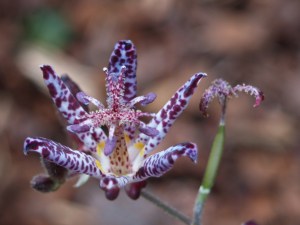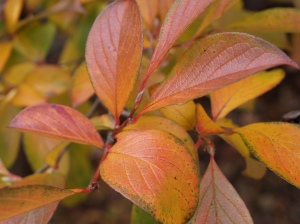Disappointments in the garden are considerable, numerous and frequent, and the gardener should not be at all surprised when a favored plant does not bloom as expected, expires suddenly, or suffers a slow, agonizing demise.

Too much water or too little, too much shade or not enough, or a cow from the farm three miles up the road finds its way to the garden and stomps the newly planted toad lily to dust, the one you had yearned for but not gotten around to ordering for nearly a decade, which until yesterday was blooming splendidly. Or, some such nonsense.
The point is that bad things will happen, and the gardener must be aware of this, and instead appreciate the everyday wonders, the blooms, buds, and berries, the bees, butterflies, and autumn foliage colors.
 I can recall many failures, trees, shrubs, and perennials that have died, patios that have sunk and walls that have fallen, most due to neglect on my part, but others a result of extreme weather of one sort or another. Perhaps the greatest disappointment of my gardening years was suffered almost twenty years ago, and it lingers in memory. When this garden was in its infancy I planted a bit of this and that, a pendulous beech, Franklinia, Katsura, an assortment of dogwoods and Japanese maples, Japanese umbrella pines, and a monkey puzzle (Araucaria araucana, below).
I can recall many failures, trees, shrubs, and perennials that have died, patios that have sunk and walls that have fallen, most due to neglect on my part, but others a result of extreme weather of one sort or another. Perhaps the greatest disappointment of my gardening years was suffered almost twenty years ago, and it lingers in memory. When this garden was in its infancy I planted a bit of this and that, a pendulous beech, Franklinia, Katsura, an assortment of dogwoods and Japanese maples, Japanese umbrella pines, and a monkey puzzle (Araucaria araucana, below).
 All went well for a year, and after two all were growing to my delight, and then the monkey puzzle died. Practically overnight. I can’t say that there were no signs of its imminent doom because I had no reason to examine it closely, and perhaps there were indications that it was on its way out, but none that cried out, and so it was disturbing when one day I looked and it was brown.
All went well for a year, and after two all were growing to my delight, and then the monkey puzzle died. Practically overnight. I can’t say that there were no signs of its imminent doom because I had no reason to examine it closely, and perhaps there were indications that it was on its way out, but none that cried out, and so it was disturbing when one day I looked and it was brown.
In travels to Oregon I had long admired the occasional monkey puzzle I would encounter, and for years I searched nurseries in the region for a tree of reasonable size before finally acquiring a fine, four foot tall specimen. I had not a clue whether it would survive the acidic clay of the garden, or the high summer heat and humidity, but I had not seen this plant at home and was mightily determined to succeed with this novelty. I was encouraged that it survived the first year, and often a finicky plant will flourish once it has lived through the first year after transplanting, but it was not to be.
Now, monkey puzzle is not an ordinary dead tree. The tree is cloaked in dagger-like spines when alive, but dead, the tree cannot be handled with gloves lest the leather be torn to shreds. The dead tree stood in place for many months until I was able to push the decaying trunk over with my boot, and even then the spines left an indelible impression.
And so the point of this overly long story is that the most desired plants might fail, but that every day there are amazing and beautiful sights in the garden, and that the memory of the failure of the monkey puzzle endures to this day due only to the pain inflicted in removing it.
My father just cut down my dead Monkey Puzzle tree. It died over a year ago and we stared at it every day pondering how to remove it. Plus, I wasn’t ready to let it go. I had that tree since it was a sprig. I hauled it around from place to place in a pot for about three years. It lived even when the pot broke and I left it lying on it’s side for a couple of months. It was tough as nails, I thought. A survivor in the Texas heat. Then after 10 years planted in my garden, it just died. But there is still hope. We saw little shoots coming up from the ground. I’ve looked around online, but haven’t seen anyone say that their tree rose from the ashes. If any tree could do it, this one would – ornery little cuss. Anyway, just had to share.
A plant with an established root system will often survive trauma to regrow from the root. In many cases the plant reacts as if it had been pruned and sends out multiple shoots from the base. I would give each of these shoots a season to grow, and presuming that you’d like a single trunked tree I would select the strongest and remove the others. I’m sure that you’ll treasure your monkey puzzle even more after its return from the dead.